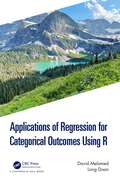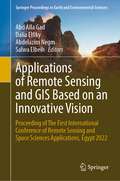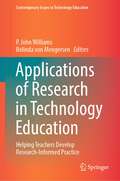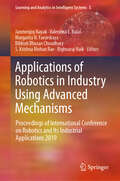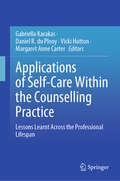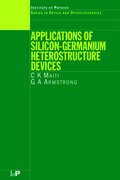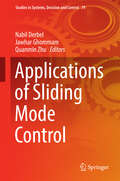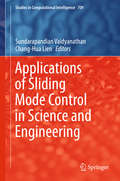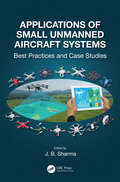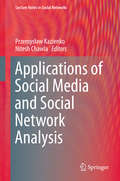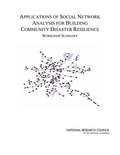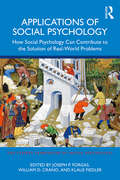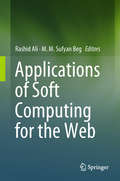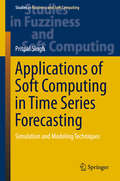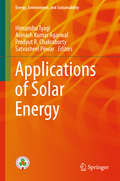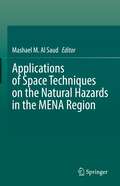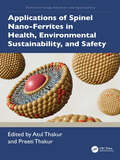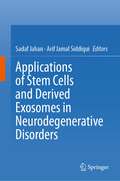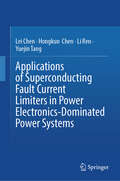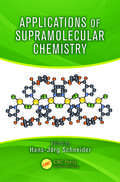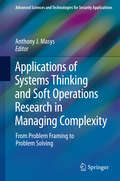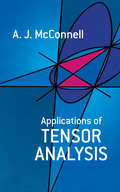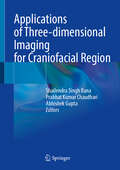- Table View
- List View
Applications of Regression for Categorical Outcomes Using R
by David Melamed Long DoanThis book covers the main models within the GLM (i.e., logistic, Poisson, negative binomial, ordinal, and multinomial). For each model, estimations, interpretations, model fit, diagnostics, and how to convey results graphically are provided. There is a focus on graphic displays of results as these are a core strength of using R for statistical analysis. Many in the social sciences are transitioning away from using Stata, SPSS and SAS, to using R, and this book uses statistical models which are relevant to the social sciences. Social Science Applications of Regression for Categorical Outcomes Using R will be useful for graduate students in the social sciences who are looking to expand their statistical knowledge, and for Quantitative social scientists due to it’s ability to act as a practitioners guide. Key Features: Applied- in the sense that we will provide code that others can easily adapt Flexible- R is basically just a fancy calculator. Our programs will enable users to derive quantities that they can use in their work Timely- many in the social sciences are currently transitioning to R or are learning it now. Our book will be a useful resource Versatile- we will write functions into an R package that can be applied to all of the regression models we will cover in the book Aesthetically pleasing- one advantage of R relative to other software packages is that graphs are fully customizable. We will leverage this feature to yield high-end graphical displays of results Affordability- R is free. R packages are free. There is no need to purchase site licenses or updates.
Applications of Remote Sensing and GIS Based on an Innovative Vision: Proceeding of The First International Conference of Remote Sensing and Space Sciences Applications, Egypt 2022 (Springer Proceedings in Earth and Environmental Sciences)
by Abdelazim Negm Abd Alla Gad Dalia Elfiky Salwa ElbeihThis book covers various aspects of remote sensing and geographic information systems, from the perspective of earth and environmental sciences. The theme of applications of remote sensing and geographic information systems for the purposes of sustainable development highlights the innovative usage of space imaged spectral data in soil characterization. This book merges the selected contributions to the First International Conference of Remote Sensing and Space Sciences Applications (Egypt 2022) aiming to promote the latest findings on the development of Space Technologies and Applications.
Applications of Research in Technology Education: Helping Teachers Develop Research-Informed Practice (Contemporary Issues in Technology Education)
by P. John Williams Belinda Von MengersenThis book brings together significant international research in technology education through a focus on contemporary Ph.D. theses. It highlights the conceptual underpinnings and methodology of each research project and elaborates on how the findings are relevant for practitioners. This book addresses the common disjunction between research conducted and an awareness of that research by practitioners. It examines the extent to which the research aligns with different justifications for teaching technology in schools in economic, utilitarian, democratic, cultural, and other such contexts.
Applications of Robotics in Industry Using Advanced Mechanisms: Proceedings of International Conference on Robotics and Its Industrial Applications 2019 (Learning and Analytics in Intelligent Systems #5)
by Margarita N. Favorskaya Janmenjoy Nayak Bighnaraj Naik Valentina E. Balas Bibhuti Bhusan Choudhury S. Krishna Mohan RaoThis book shares important findings on the application of robotics in industry using advanced mechanisms, including software and hardware. It presents a collection of recent trends and research on various advanced computing paradigms such as soft computing, robotics, smart automation, power control, and uncertainty analysis. The book constitutes the proceedings of the 1st International Conference on Application of Robotics in Industry using Advanced Mechanisms (ARIAM2019), which offered a platform for sharing original research findings, presenting innovative ideas and applications, and comparing notes on various aspects of robotics. The contributions highlight the latest research and industrial applications of robotics, and discuss approaches to improving the smooth functioning of industries. Moreover, they focus on designing solutions for complex engineering problems and designing system components or processes to meet specific needs, with due considerations for public health and safety, including cultural, societal, and environmental considerations. Taken together, they offer a valuable resource for researchers, scientists, engineers, professionals and students alike.
Applications of Self-Care Within the Counselling Practice: Lessons Learnt Across the Professional Lifespan
by Margaret Anne Carter Vicki Hutton Gabriella Karakas Daniel R. du PlooyThis volume presents counsellors' self-care journeys across all stages of the professional lifespan—early career, mid-career, and tenured professional. Each chapter presents a contributor's personal reflection and insight on sustaining oneself in the field through a strengths-based, autoethnographic lens. Addressing challenges like burnout, structural barriers, and global events (e.g., pandemics, natural disasters, and human rights movements), the collection highlights the realities of balancing self-care while supporting others. Although all affiliated with ACAP University College, the contributors bring unique perspectives shaped by personal experiences—such as motherhood, caregiving, grief, and cultural contexts—and professional backgrounds in clinical psychology, research, allied health, trauma-informed care, and multidisciplinary practice. Aimed at inspiring emerging counsellors and students while offering insights to seasoned professionals, this volume provides practical strategies on how resilience and longevity can be supported across the counselling profession.
Applications of Silicon-Germanium Heterostructure Devices (Series in Optics and Optoelectronics)
by C.K Maiti G.A ArmstrongThe first book to deal with the design and optimization of transistors made from strained layers, Applications of Silicon-Germanium Heterostructure Devices combines three distinct topics-technology, device design and simulation, and applications-in a comprehensive way. Important aspects of the book include key technology issues for the growth of st
Applications of Sliding Mode Control (Studies in Systems, Decision and Control #79)
by Quanmin Zhu Nabil Derbel Jawhar GhommamThis book presents essential studies and applications in the context of sliding mode control, highlighting the latest findings from interdisciplinary theoretical studies, ranging from computational algorithm development to representative applications. Readers will learn how to easily tailor the techniques to accommodate their ad hoc applications. To make the content as accessible as possible, the book employs a clear route in each paper, moving from background to motivation, to quantitative development (equations), and lastly to case studies/illustrations/tutorials (simulations, experiences, curves, tables, etc. ). Though primarily intended for graduate students, professors and researchers from related fields, the book will also benefit engineers and scientists from industry.
Applications of Sliding Mode Control in Science and Engineering (Studies in Computational Intelligence #709)
by Sundarapandian Vaidyanathan Chang-Hua LienGathering 20 chapters contributed by respected experts, this book reports on the latest advances in and applications of sliding mode control in science and engineering. The respective chapters address applications of sliding mode control in the broad areas of chaos theory, robotics, electrical engineering, physics, chemical engineering, memristors, mechanical engineering, environmental engineering, finance, and biology. Special emphasis has been given to papers that offer practical solutions, and which examine design and modeling involving new types of sliding mode control such as higher order sliding mode control, terminal sliding mode control, super-twisting sliding mode control, and integral sliding mode control. This book serves as a unique reference guide to sliding mode control and its recent applications for graduate students and researchers with a basic knowledge of electrical and control systems engineering.
Applications of Small Unmanned Aircraft Systems: Best Practices and Case Studies
by J. B. SharmaAdvances in high spatial resolution mapping capabilities and the new rules established by the Federal Aviation Administration in the United States for the operation of Small Unmanned Aircraft Systems (sUAS) have provided new opportunities to acquire aerial data at a lower cost and more safely versus other methods. A similar opening of the skies for sUAS applications is being allowed in countries across the world. Also, sUAS can access hazardous or inaccessible areas during disaster events and provide rapid response when needed. Applications of Small Unmanned Aircraft systems: Best Practices and Case Studies is the first book that brings together the best practices of sUAS applied to a broad range of issues in high spatial resolution mapping projects. Very few sUAS pilots have the knowledge of how the collected imagery is processed into value added mapping products that have commercial and/or academic import. Since the field of sUAS applications is just a few years old, this book covers the need for a compendium of case studies to guide the planning, data collection, and most importantly data processing and map error issues, with the range of sensors available to the user community. Written by experienced academics and professionals, this book serves as a guide on how to formulate sUAS based projects, from choice of a sUAS, flight planning for a particular application, sensors and data acquisition, data processing software, mapping software and use of the high spatial resolution maps produced for particular types of geospatial modeling. Features: Focus on sUAS based data acquisition and processing into map products Broad range of case studies by highly experienced academics Practical guidance on sUAS hardware, sensors, and software utilized Compilation of workflow insights from expert professors and professionals Relevant to academia, government, and industry Positional and thematic map accuracy, UAS curriculum development and workflow replicability issues This book would be an excellent text for upper-level undergraduate to graduate level sUAS mapping application courses. It is also invaluable as a reference for educators designing sUAS based curriculum as well as for potential sUAS users to assess the scope of mapping projects that can be done with this technology.
Applications of Social Media and Social Network Analysis (Lecture Notes in Social Networks)
by Przemysław Kazienko Nitesh ChawlaThis collection of contributed chapters demonstrates a wide range of applications within two overlapping research domains: social media analysis and social network analysis. Various methodologies were utilized in the twelve individual chapters including static, dynamic and real-time approaches to graph, textual and multimedia data analysis. The topics apply to reputation computation, emotion detection, topic evolution, rumor propagation, evaluation of textual opinions, friend ranking, analysis of public transportation networks, diffusion in dynamic networks, analysis of contributors to communities of open source software developers, biometric template generation as well as analysis of user behavior within heterogeneous environments of cultural educational centers. Addressing these challenging applications is what makes this edited volume of interest to researchers and students focused on social media and social network analysis.
Applications of Social Network Analysis for Building Community Disaster Resilience: Workshop Summary
by National Research Council of the National AcademiesSocial Network Analysis (SNA) is the identification of the relationships and attributes of members, key actors, and groups that social networks comprise. The National Research Council, at the request of the Department of Homeland Security, held a two-day workshop on the use of SNA for the purpose of building community disaster resilience. The workshop, summarized in this volume, was designed to provide guidance to the DHS on a potential research agenda that would increase the effectiveness of SNA for improving community disaster resilience. The workshop explored the state of the art in SNA and its applications in the identification, construction, and strengthening of networks within U.S. communities. Workshop participants discussed current work in SNA focused on characterizing networks; the theories, principles and research applicable to the design or strengthening of networks; the gaps in knowledge that prevent the application of SNA to the construction of networks; and research areas that could fill those gaps. Elements of a research agenda to support the design, development, and implementation of social networks for the specific purpose of strengthening community resilience against natural and human-made disasters were discussed.
Applications of Social Psychology: How Social Psychology Can Contribute to the Solution of Real-World Problems (Sydney Symposium of Social Psychology)
by Klaus Fiedler William D. Crano Joseph P. ForgasThis book explores what social psychology can contribute to our understanding of real-life problems and how it can inform rational interventions in any area of social life. By reviewing some of the most recent achievements in applying social psychology to pressing contemporary problems, Forgas, Crano, and Fiedler convey a fundamentally optimistic message about social psychology’s achievements and prospects. The book is organized into four sections. Part I focuses on the basic issues and methods of applying social psychology to real-life problems, discussing evolutionary influences on human sociability, the role of psychological ‘mindsets’ in interpreting reality, and the use of attitude change techniques to promote adaptive behaviors. Part II explores the applications of social psychology to improve individual health and well-being, including managing aggression, eating disorders, and improving therapeutic interactions. Part III turns to the application of social psychology to improve interpersonal relations and communication, including attachment processes in social relationships, the role of parent-child interaction in preventing adolescent suicide, and analyzing social relations in legal settings and online social networks. Finally, Part IV addresses the question of how social psychology may improve our understanding of public affairs and political behavior. The book will be of interest to students and academics in social psychology, and professionals working in applied settings.
Applications of Soft Computing for the Web
by Rashid Ali Mm Sufyan BegThis book discusses the applications of different soft computing techniques for the web-based systems and services. The respective chapters highlight recent developments in the field of soft computing applications, from web-based information retrieval to online marketing and online healthcare. In each chapter author endeavor to explain the basic ideas behind the proposed applications in an accessible format for readers who may not possess a background in these fields. This carefully edited book covers a wide range of new applications of soft computing techniques in Web recommender systems, Online documents classification, Online documents summarization, Online document clustering, Online market intelligence, Web usage profiling, Web data extraction, Social network extraction, Question answering systems, Online health care, Web knowledge management, Multimedia information retrieval, Navigation guides, User profiles extraction, Web-based distributed information systems, Web security applications, Internet of Things Applications and so on. The book is aimed for researchers and practitioner who are engaged in developing and applying intelligent systems principles for solving real-life problems. Further, it has been structured so that each chapter can be read independently of the others.
Applications of Soft Computing in Time Series Forecasting: Simulation and Modeling Techniques (Studies in Fuzziness and Soft Computing #330)
by Pritpal SinghThis book reports on an in-depth study of fuzzy time series (FTS) modeling. It reviews and summarizes previous research work in FTS modeling and also provides a brief introduction to other soft-computing techniques, such as artificial neural networks (ANNs), rough sets (RS) and evolutionary computing (EC), focusing on how these techniques can be integrated into different phases of the FTS modeling approach. In particular, the book describes novel methods resulting from the hybridization of FTS modeling approaches with neural networks and particle swarm optimization. It also demonstrates how a new ANN-based model can be successfully applied in the context of predicting Indian summer monsoon rainfall. Thanks to its easy-to-read style and the clear explanations of the models, the book can be used as a concise yet comprehensive reference guide to fuzzy time series modeling, and will be valuable not only for graduate students, but also for researchers and professionals working for academic, business and government organizations.
Applications of Solar Energy (Energy, Environment, and Sustainability)
by Avinash Kumar Agarwal Himanshu Tyagi Prodyut R. Chakraborty Satvasheel PowarThis book focuses on solar-energy-based renewable energy systems and discusses the generation of electric power using solar photovoltaics, as well as some new techniques, such as solar towers, for both residential and commercial needs. Such systems have played an important role in the move towards low-emission and sustainable energy sources. The book covers a variety of applications, such as solar water heaters, solar air heaters, solar drying, nanoparticle-based direct absorption solar systems, solar volumetric receivers, solar-based cooling systems, solar-based food processing and cooking, efficient buildings using solar energy, and energy storage for solar thermal systems. Given its breadth of coverage, the book offers a valuable resource for researchers, students, and professionals alike.
Applications of Space Techniques on the Natural Hazards in the MENA Region
by Mashael M. Al SaudThis book introduces a comprehensive understanding in the use of space techniques in natural hazards and risk management in the MENA Region. The book is based on different case-studies from 25 MENA countries, and will be useful in highlighting the issues from all aspects. In recent years the number of natural hazard events has increased in the MENA Region. This is exacerbated by the changing climate and extreme climate events, as well as a large increase in the population in this area. Disastrous events occur on a yearly basis characterized by a vulnerability of physical processes. Floods, earthquakes, and mass movement result in severe damage to property and livelihoods, and have devastating effects upon the environment. These events cause severe financial losses, which on an annual basis, can exceed millions of dollars. The predication, assessment and monitoring approaches remain inadequate in managing these hazards and in mitigating their impacts, but with the development of space techniques and geo-information systems, these situations can now be better managed. The miscellany of satellite images, with different spatial and temporal resolutions, enable the detection of terrain features and provide indications of potential natural risks. This book will of interest to stakeholders, including field experts, academics, researchers and decision makers.
Applications of Spinel Nano-Ferrites in Health, Environmental Sustainability, and Safety (Nanotechnology Advances and Applications)
by Atul Thakur Preeti ThakurThis book presents the foundational concepts of spinel nano-ferrites, their synthesis techniques, and their cutting-edge applications in various fields. The book begins with an introduction to spinel nano-ferrites, discussing their unique properties and historical context. It then delves into various synthesis techniques, such as sol-gel methods, co-precipitation, and hydrothermal processes, highlighting the influence of these methods on the resultant structures and morphologies. The book also reviews the electrical and magnetic characteristics of spinel nano-ferrites, demonstrating their potential in electronic and magnetic devices. The role of spinel nano-ferrites in the health sector is explored in depth, detailing their use as antibacterial and antifungal agents and their innovative applications in magnetic resonance imaging (MRI), cancer detection, targeted drug delivery, and hyperthermia treatment. The chapters further examine the environmental applications of spinel nano-ferrites, including their effectiveness in pollution remediation, water purification, dye degradation, and the detection and removal of heavy metal ions and microplastics from wastewater. Toward the end, the book explores the development of gas sensors and humidity sensors using spinel nano-ferrites, as well as devices designed for human and environmental safety. This book is intended for researchers and students of nanotechnology, nanobiotechnology, healthcare professionals, and environmental scientists.Key Features: Covers foundational concepts, unique properties, and cutting-edge applications of spinel nano-ferrites Explores various synthesis methods such as sol-gel, co-precipitation, and hydrothermal processes, and their impact on structures and morphologies of spinel nano-ferrites Discusses the electrical and magnetic characteristics of spinel nano-ferrites Examines the potential of spinel nano-ferrites as antibacterial and antifungal agents, and their roles in MRI, cancer detection, and drug delivery Highlights the effectiveness of spinel nano-ferrites in pollution remediation, water purification, and dye degradation
Applications of Statistics and Probability in Civil Engineering
by M. H. Faber J. Köhler K. NishijimaUnder the pressure of harsh environmental conditions and natural hazards, large parts of the world population are struggling to maintain their livelihoods. Population growth, increasing land utilization and shrinking natural resources have led to an increasing demand of improved efficiency of existing technologies and the development of new ones. A
Applications of Stem Cells and derived Exosomes in Neurodegenerative Disorders
by Sadaf Jahan Arif Jamal SiddiquiThis book explores the therapeutic approaches of stem cells and stem cell-derived exosomes against neurodegenerative disorders (NDDs). The initial chapters introduce different neurodegenerative diseases and discuss the mechanistic aspects of their progression. The subsequent chapters cover strategies for the isolation, characterization, and differentiation of stem cells. In turn, the book reviews the protective role of stem cells against neurological disorders and examines regenerative approaches to treat neurological diseases using mesenchymal stem cells. The book also presents induced pluripotent stem cell (iPSC) technology for cellular therapy, drug screening, and in-vitro modeling of neurodegenerative diseases. Lastly, the book discusses the role of stem cells and derived exosomes as a novel therapeutic agent against Alzheimer's and Parkinson's disease and in associated signaling molecules involved in neuroprotection. This book is an invaluable source for researchers working towards understanding the potential of stem cell therapy in neurodegenerative disorders.
Applications of Superconducting Fault Current Limiters in Power Electronics-Dominated Power Systems
by Lei Chen Hongkun Chen Li Ren Yuejin TangThe book discusses superconducting fault current limiters and their applications in power systems, exploring the principles, simulations and engineering practices, but focusing on systematic applications in traditional and renewable power systems. It provides in-depth studies on a number of major topics such as architecture of superconducting fault current limiter, device design, parameter optimization, prototype testing, co-ordination control and performance evaluation. It also describes multiple application cases of superconducting fault current limiters, which are applied in high voltage direct current transmission systems, active distribution networks, and micro-grids. Offering a comprehensive and systematic overview of practical issues, the book is intended for readers wanting to learn practical approaches for developing superconducting fault current limiters. It also appeals to researchers, engineers and graduate students in various fields, including high-temperature superconducting materials, power system transient stability, and control science and engineering.
Applications of Supramolecular Chemistry
by Hans-Jörg SchneiderApplications of Supramolecular Chemistry introduces the use of non-covalent interactions and molecular recognition for many fields. Applications include the analysis of technically, medically, and environmentally important chemical compounds, their separation, purification and removal, and the design of new materials, including supramolecular elect
Applications of Systems Thinking and Soft Operations Research in Managing Complexity: From Problem Framing to Problem Solving (Advanced Sciences and Technologies for Security Applications)
by Anthony J. MasysThis book captures current trends and developments in the field of systems thinking and soft operations research which can be applied to solve today's problems of dynamic complexity and interdependency. Such 'wicked problems' and messes are seemingly intractable problems characterized as value-laden, ambiguous, and unstable, that resist being tamed by classical problem solving. Actions and interventions associated with this complex problem space can have highly unpredictable and unintended consequences. Examples of such complex problems include health care reform, global climate change, transnational serious and organized crime, terrorism, homeland security, human security, disaster management, and humanitarian aid. Moving towards the development of solutions to these complex problem spaces depends on the lens we use to examine them and how we frame the problem. It will be shown that systems thinking and soft operations research has had great success in contributing to the management of complexity.
Applications of Tensor Analysis (Dover Books on Mathematics)
by A. J. McConnellThis standard work applies tensorial methods to subjects within the realm of advanced college mathematics. In its four main divisions, it explains the fundamental ideas and the notation of tensor theory; covers the geometrical treatment of tensor algebra; introduces the theory of the differentiation of tensors; and applies mathematics to dynamics, electricity, elasticity, and hydrodynamics.Partial contents: algebraic preliminaries (notation, definitions, determinants, tensor analysis); algebraic geometry (rectilinear coordinates, the plane, the straight line, the quadric cone and the conic, systems of cones and conics, central quadrics, the general quadric, affine transformations); differential geometry (curvilinear coordinates, covariant differentiation, curves in a space, intrinsic geometry of a surface, fundamental formulae of a surface, curves on a surface); applied mathematics (dynamics of a particles, dynamics of rigid bodies, electricity and magnetism, mechanics of continuous media, special theory of relativity).
Applications of Three-dimensional Imaging for Craniofacial Region
by Abhishek Gupta Prabhat Kumar Chaudhari Shailendra Singh RanaThe book provides sound knowledge of 3D imaging of dentofacial craniofacial region. It guides the students and faculty for understanding the dentofacial craniofacial region in depth. It incorporates the latest techniques, frameworks and technologies in the imaging area of oral health. The book emphasizes on the dentofacial and craniofacial region and thus fills the gap in the medical imaging literature. The development in this book is not only on the imaging techniques but also emphasis will be on the three-dimensional (3D) frameworks to deal the patients for their diagnosis and treatment planning. The chapters of this book are designed in such a way that the readers may get the complete package of the exploration of the imaging clinical applications of craniofacial areas. This book will be helpful not only for the students and faculty but also for the researchers working in the relevant areas.This book will provide easy, simple way but the most authentic material to learn the craniofacial region imaging. In this manual we will incorporates authentic, internationally accepted terms and definition. To make it interesting and simple, our approach is to incorporate the material in systematic manner in a simple and easy way by incorporating maximum illustrations and flowcharts. This book provides sound knowledge of various advanced technologies for dentist imaging. This book will highlights the importance and explore the current research in the dentofacial and craniofacial areas.
Applications of Topological Methods in Molecular Chemistry (Challenges and Advances in Computational Chemistry and Physics #22)
by Remi Chauvin Christine Lepetit Bernard Silvi Esmail AlikhaniThis is the first edited volume that features two important frameworks, Hückel and quantum chemical topological analyses. The contributors, which include an array of academics of international distinction, describe recent applications of such topological methods to various fields and topics that provide the reader with the current state-of-the-art and give a flavour of the wide range of their potentialities.
